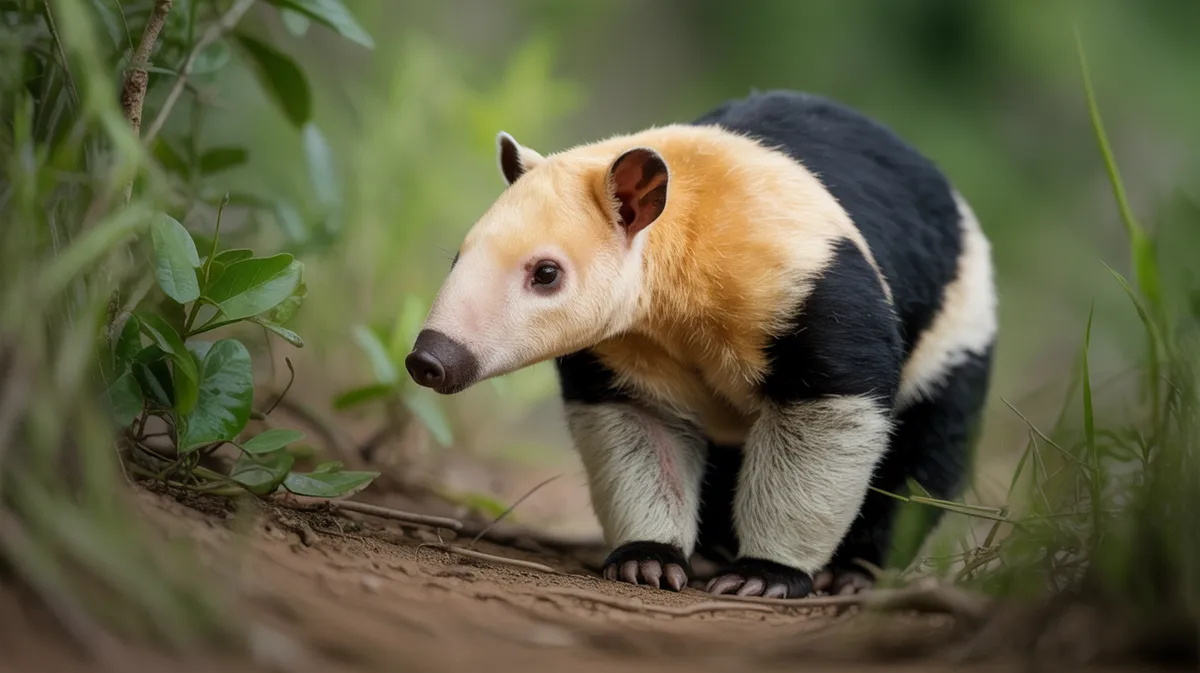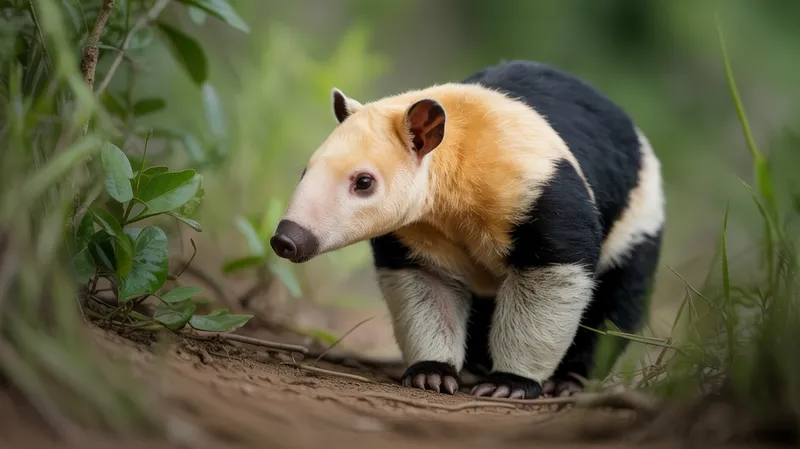
Southern Tamandua
Tamandua tetradactyla

Meet the Southern Tamandua
The Southern Tamandua is a medium-sized anteater native to South America, recognizable by its distinctive long snout and prehensile tail. Its coarse fur is typically pale yellow with a black 'vest' pattern on its shoulders and back, though coloration varies across its range. Adapted for arboreal and terrestrial life, the Southern Tamandua is an expert climber, using its strong forelimbs and curved claws to access ant and termite nests in trees and on the ground. Mostly solitary and nocturnal, it relies on its keen sense of smell to find food. This unique mammal plays a significant role in controlling insect populations within its habitat.
Classification
Mammal
Habitat
Forests and savannas of South America
Diet
Insectivore
Lifespan
9-12 years
Conservation
Least Concern
Weight
4-8.4 kg
📖Fascinating Facts
Claw Defense
The Southern Tamandua uses its large, curved foreclaws as a primary defense, standing on its hind legs and swinging powerfully when threatened.
Arboreal Lifestyle
This anteater spends much of its time in trees, navigating branches with its strong, prehensile tail, which acts like a fifth limb for balance and gripping.
Super Sniffer
Lacking good eyesight, the Southern Tamandua relies on an extraordinary sense of smell to locate insect colonies hidden in wood or underground.
📋Detailed Description
The Southern Tamandua (Tamandua tetradactyla) is a medium-sized anteater, typically weighing between 3.5 and 8.4 kg (7.7–18.5 lbs) and measuring 53–88 cm (21–35 in) in body length, with a prehensile tail adding another 40–67 cm (16–26 in). Its body is robust, covered in coarse, bristly fur that varies from pale yellow or cream to brown, often featuring a distinctive black 'vest' pattern along the shoulders and back, though coloration can differ regionally. The elongated, tubular snout houses a long, sticky tongue—up to 40 cm (16 in)—adapted for extracting insects from narrow crevices. The forelimbs are particularly powerful, ending in four digits with large, curved claws, especially prominent on the third digit, which are used for tearing open insect nests and for defense. The hind feet have five toes, with the first toe reduced. The prehensile tail is partially hairless on the underside, providing a strong grip for climbing. Southern Tamanduas are both arboreal and terrestrial, moving with a distinctive gait due to their claws, which they tuck under when walking. They possess a keen sense of smell, compensating for poor eyesight and hearing. Solitary by nature, individuals maintain overlapping home ranges and communicate through scent marking and occasional vocalizations. They are primarily nocturnal but may be active during the day in undisturbed areas. Their flexible diet and ability to thrive in a variety of habitats, from rainforests to dry savannas and gallery forests, contribute to their wide distribution across South America and Trinidad.
💡 Did you know?
Unlike many mammals, the Southern Tamandua has no teeth—it uses its tongue and strong stomach muscles to process its insect prey.
🔬Research & Sources
Wikipedia Summary
The southern tamandua, also called the collared anteater or lesser anteater, is a species of anteater from South America and the island of Trinidad in the Caribbean. It is a solitary animal found in many habitats, from mature to highly disturbed secondary forests and arid savannas. It feeds on ants, termites, and bees. Its very strong foreclaws can be used to break insect nests or to defend itself.
Last Modified: 5/21/2025
🎭Behavior & Social Structure
Southern Tamanduas are solitary and largely nocturnal, though diurnal activity is observed in areas with minimal human disturbance. They spend significant time foraging both in trees and on the ground, using their acute sense of smell to locate insect nests. Feeding involves using their formidable foreclaws to tear open nests of ants, termites, and occasionally bees, after which they insert their long, sticky tongue to consume prey. They can consume up to 9,000 insects in a single day. Tamanduas avoid eating soldier ants and termites, focusing on less aggressive species. They are adept climbers, often seen moving slowly and deliberately along branches, using their prehensile tail for balance and support. When threatened, they assume a defensive posture: standing on their hind legs and tail, forelimbs raised and claws extended. Communication is primarily through scent marking from anal glands, but they may vocalize with hisses, snorts, or grunts when disturbed. Home ranges can overlap, but direct interactions are rare outside of mating.
👶Reproduction & Life Cycle
Southern Tamanduas are polygynous, with males seeking out receptive females during the breeding season, which varies geographically but often peaks in spring and summer. Courtship involves scent marking and following, with copulation occurring on the ground or in trees. Females give birth to a single offspring after a gestation period of approximately 130–150 days. Neonates are born with eyes open and a soft, short coat, often lighter in color than adults. The young ride on the mother's back for several months, clinging to her fur as she forages. Weaning occurs at 3–6 months, but juveniles may remain with the mother for up to a year. Parental care is provided exclusively by the female; males do not participate in rearing. Sexual maturity is reached at 1–2 years of age.
🛡️Adaptations & Survival
The Southern Tamandua exhibits several specialized adaptations for myrmecophagy (ant and termite eating). Its elongated, toothless snout and extremely long, sticky tongue allow it to access insects deep within nests. Strong forelimbs and enlarged claws are used for breaking open tough nest structures and for defense against predators. The prehensile tail aids in climbing and stability in the arboreal environment. Tamanduas have thick, coarse fur that provides protection from insect bites and stings. Their metabolism is relatively low, matching the low caloric content of their insectivorous diet. The digestive tract is simple, with a highly acidic stomach to digest chitin and neutralize formic acid from ants. Behaviorally, their solitary and cryptic lifestyle reduces competition and predation risk.
📚Research Sources
🎨Cultural Significance
The Southern Tamandua holds a modest place in local folklore and indigenous traditions across its range. In some South American cultures, it is associated with mystical or medicinal beliefs, and its claws are sometimes used as amulets or tools. Its defensive posture and unusual appearance have inspired stories and myths, often portraying the animal as both comical and formidable. However, it is not a major figure in regional mythology compared to other native mammals.
🔬Recent Research & Discoveries
Recent research on Tamandua tetradactyla has focused on its ecological role as a regulator of insect populations and its adaptability to fragmented landscapes. Genetic studies have revealed significant population structure across its range, suggesting possible cryptic subspecies or local adaptations. Studies on their diet using stable isotope analysis have confirmed their reliance on a wide variety of social insects and highlighted their flexibility in response to habitat disturbance. Ongoing research includes the impact of habitat fragmentation on movement patterns, home range size, and genetic diversity. There is also interest in their unique immune adaptations, as they are exposed to a wide range of insect-borne pathogens.
🎥Wildlife Videos

Tamandua amazonico | Documental de Animales
Tamandua amazonico | Documental de Animales Contenido formativo de animales el tamandua amazonico, es uno de esos ...
Cityanimal

TAMANDUA (Ant Eater) Chat
Subscribe: http://bit.ly/SubscribeDallasZooTube Follow the Dallas Zoo: Official Site: http://bit.ly/DallasZooOfficialSite ZooHoo Blog: ...
Dallas Zoo

The Cutest Ant Eater In The World | Tamandua
The Northern Tamandua is my favorite animal here, at the Costa Rican Sanctuary. It is the smaller cousin of the Giant Ant Eater, ...
That's Wild

The Amazing Anteater: Evolution, Survival, and the Challenges They Face Today#anteater#giantanteater
The Amazing Anteater: Evolution, Survival, and the Challenges They Face Today#anteater #giant anteater Have you ever ...
Animal Variation

Anteater - 5 Minute Documentary
Step into the fascinating world of the anteater with an engaging five-minute documentary that uncovers the remarkable life and ...
Five Minute Documentaries

Tamandua: The Anteater With a Secret Weapon: Sticky Fingers! #12k #8k #4k #viral #trending #viral
Explore the tamandua's remarkable adaptations for efficiently capturing and consuming insects. Explain how their long, sticky ...
Natural Thrill
🌍Habitat Information
The Southern Tamandua typically inhabits Forests and savannas of South America environments. Southern Tamanduas have adapted to their environments with specialized features and behaviors.
Primary Habitat:
Forests and savannas of South America
More detailed habitat information will be available soon.
🛡️Conservation Status
The Southern Tamandua is currently classified as Least Concern. Conservation efforts are crucial for preserving this species for future generations.
Common Threats:
- 🏠Habitat loss and fragmentation
- 🌡️Climate change impacts
- 🎯Hunting and poaching
- 🏭Human-wildlife conflict
⚠️Threats & Conservation Challenges
While currently listed as Least Concern by the IUCN, Southern Tamanduas face localized threats including habitat loss due to deforestation, agricultural expansion, and urbanization. Road mortality is a significant risk in fragmented habitats. They are sometimes hunted for their meat or captured for the pet trade, though this is not widespread. In some regions, they are killed due to the mistaken belief that they prey on livestock or because of their perceived threat when encountered. Despite these pressures, their adaptability to disturbed habitats and broad diet have allowed populations to remain stable in many areas. However, continued habitat fragmentation and increased human-wildlife conflict could pose future challenges.
🔬Scientific Classification
Scientific Name
Tamandua tetradactyla
Classification Hierarchy
🔍 About Taxonomic Classification
Taxonomic classification is a hierarchical system used by scientists to classify and organize living organisms based on shared characteristics and evolutionary relationships.
The system moves from broad categories (Kingdom) to increasingly specific ones, with each animal's scientific name typically consisting of its Genus and species.
📝Community Notes
Share your observations and insights about the Southern Tamandua with our community of wildlife enthusiasts.
Join Our Community
Sign in to share your observations and connect with fellow wildlife enthusiasts.
Sign In to ContributeNo community notes yet
Be the first to share your observations about the Southern Tamandua!
Explore Southern Tamandua
Select a tab above to learn more about this amazing animal.
📸Photo Gallery
No photos available for this animal yet.
🌟Discover More Wildlife
Continue your journey of discovery with more fascinating animals from our database
